E-Scooter, Informational
How does e-scooters work?

Electric scooters are becoming increasingly popular as a convenient and eco-friendly mode of transportation. But have you ever wondered how these sleek machines work? As a University of Auckland student passionate about electric scooters, I’m excited to break it down for you in a simple and informative way.
The Basics of Electric Scooters
At its core, an electric scooter consists of a few main components: the battery, the motor, the controller, and the frame. Each of these parts plays a crucial role in making the scooter move.
The Battery
The battery is the powerhouse of the electric scooter. It stores the electrical energy that powers the motor. Most electric scooters use lithium-ion batteries because they are lightweight, have a high energy density, and can be recharged hundreds of times. When you plug in your scooter to charge, you’re replenishing the battery’s energy reserves.
The Motor
The motor is what drives the wheels of the scooter. It’s typically located in one of the wheels (known as a hub motor) or in the frame with a chain or belt connecting it to the wheels. There are two types of motors commonly used in electric scooters: brushed and brushless. Brushless motors are more efficient and have a longer lifespan compared to brushed motors. When the battery sends power to the motor, it generates rotational motion, propelling the scooter forward.
The Controller
The controller is the brain of the electric scooter. It regulates the power flow from the battery to the motor based on the rider’s input. This component is crucial for managing speed and ensuring a smooth ride. Advanced controllers can also offer features like regenerative braking, which allows the scooter to recover some energy when slowing down. When you twist the throttle to accelerate, the controller adjusts the power sent to the motor, making the scooter go faster or slower.
The Frame
The frame of the scooter is designed to be lightweight yet sturdy enough to support the rider and the components. Modern scooters are made from materials like aluminum or carbon fiber to ensure a good balance between strength and weight. The frame also includes the deck, where the rider stands, and the handlebars, which provide steering control.
Additional Components
Beyond the main components, electric scooters also have additional features that enhance functionality and safety. These include:
- Brakes: Most electric scooters have disc brakes or drum brakes, and some even have electronic braking systems for additional stopping power.
- Lights: Front and rear lights improve visibility and safety, especially during night rides.
- Display: An onboard display shows important information such as speed, battery level, and distance traveled.
- Suspension: Some scooters have suspension systems to absorb shocks and provide a smoother ride on rough surfaces.
Summary
In summary, an electric scooter works through the interaction of its battery, motor, controller, and frame. The battery provides the energy, the motor converts that energy into motion, the controller manages the power flow, and the frame holds everything together. Additional components like brakes, lights, and suspension enhance safety and comfort. This seamless integration of parts allows electric scooters to offer a fun, efficient, and eco-friendly way to get around, making them an excellent choice for urban transportation.
